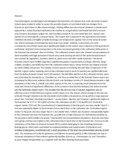| dc.description.abstract | The hydrological, morphological and biological characteristics of a Kenyan low order mountain tropical stream were studied in order to assess the possible impacts of catchment land use changes from forestry to agriculture on the stream ecology. Striking differences were found between a stream reach adjacent to a native forested catchment and another to an agricultural catchment but with a narrow strip of exotic (Eucalyptus saligna Sm. and Grevillea robusta R. Br.) and native but non- riparian tree species (Ficus thorningii BL.) along its banks. The stream reach adjacent to the agricultural catchment exhibited elevated and highly variable discharge and temperature regimes than at the native forested site, where discharge and tempeture were lower and stable. Similarly, conductivity, pH, ionic constituents and nutrient loads were significantly higher at the stream reach adjacent to the agricultural catchment. Sediment loads transported in the water-increased greately at the cultivated while water at the forested site remained clear at all times. The cultivated stream reach also showed strong evidence of bank instability with high potential of future mass bank wasting but that of the native forested reach was covered by vegetation, boulders, bedrock, plant roots and other stable materials. The native forested stream reach further depicted a significantly greater representation of large substrata (large cobbles, boulders, and bedrocks) than the cultivated stream reach, whose bottom was largely covered by small cobbles and gravel. The number of plant species constituting the leaf litter component of the benthic organic matter standing stock at the cultivated stream reach (9 species) was significantly lower than the native forested stream reach (18 species). The leaf litter detritus at the cultivated stream reach was dominated by Eucalyptus sp., Grevillea sp., and Ficus sp while that of the forested stream reach was dominated by Afrocrania volkensii (Harms) Hutch. and Dombeya torrida (J.F. Gmel) Bamps despite a high abundance of Ilex mitis (L.) Radlk. and other species at the site. A surprising result obtained from this study was the lack of significant differences in the content of leaf detritus between the native forested and the cultivated stream reach. This showed that the narrow strip of riparian vegetation was an effective source of allochthonous organic matter inputs in to the stream, whose storage at the site was achieved through retentions by the abundant small cobbles and gravel occurring within a large exposed gravel bar. Total litter standing stock (bark + woody debris + leaves), was however, significantly higher at the forested site (177.3 ? 37.5 gDW.m2) than the cultivated site (81.7? 32.9g DW.m2). Particulate organic matter (TOC and TN concentrations) in bedsediments in the fine grain size class smaller than 0.1 mm was expectedly higher at the forested stream reach than at the cultivated site. Particulate organic matter in the grain size class larger than 0.1 but smaller than 1.00mm was however unexpectedly higher at the cultivated site than the forested site, possibly due to high retension of small detrital particles by the prevalent small cobbles and gravel. Total benthic macroinvertebrate abundance, diversity, evenness and species richness was higher at the cultivated stream reach than at the forested site. Contrary to the predictions of the River Continuum Concept (RCC), animals belonging to the shredding functional feeding group, which were dominated by Lepidostomatidae and Leptoceridae (Trichoptera) and Scirtidae (Coleoptera), constituted only a small proportion of the total macroinvertebate density at both sites. The abundance of collector-gatherers and filterers increased greatly at the cultivated site due to increased abundance of the collector gathering mayflies (Caenis sp,. choroterpers sp. and Tricorythus sp.)and midges (Polypedilum sp.), together with the filter-feeding Hydropsychidae | en_US |

